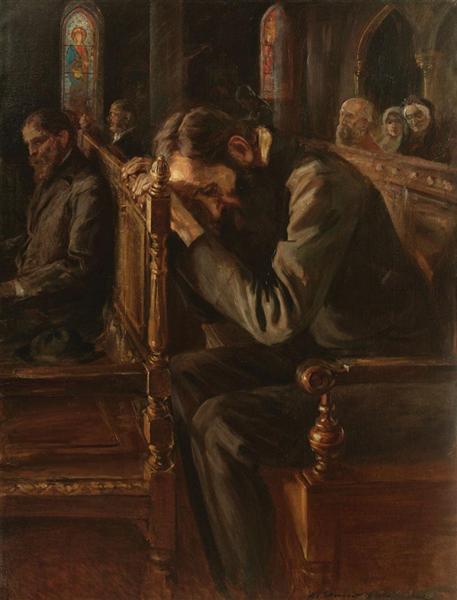Description
The painting "Slavic souls" (1900) by Nicolae Vermont is a work that reflects both the rich cultural tradition of Eastern Europe and the social and spiritual concerns of its time. This piece, which is often interpreted through the prism of the literary influence of Dostoyevski, evokes the complexity of human nature, addressing the tensions between crime and redemption, an omnipresent theme in Eslava literature and that resonates with the title of the work.
In the foreground of the composition, we find a scene full of symbolism and emotion. The portrayed characters stand out for their expressiveness, showing faces that convey a deep suffering and reflection. Faces are allusive to a humanity marked by anguish and tribulations, characteristics that Newfoundland Vermont captured with a mastery through a phenomenal treatment of light and shadow. This meticulous attention to facial expressions and gestures gives the work an almost photographic quality, revealing the artist's ability to capture the human psyché.
The color palette in "Slavic souls" is essential for the interpretation of the work. Vermont uses off and terrible tones, predominantly browns, gray and ocher, which suggest desolation and melancholy, but can also be read as a symbol of hope and resistance of the characters. The use of these colors creates a gloomy atmosphere, which is contrasted with the lighter and brighter brushstrokes in the clothing and in the elements of the environment, suggesting light sources that may be associated with redemption or forgiveness. This chromatic harmony reinforces the introspective atmosphere of the painting, allowing the viewer to feel the emotional burden faced by the individuals represented.
The compositional structure of the work is based on an elegant balance between the characters and their context. Vermont is not only limited to portraying its figures in an empty space; Instead, he integrates them into an environment that seems to vibrate alive. The landscape that surrounds them, although minimalist, suggests a broader cultural and spiritual background, rooted in Slavic traditions. Organic forms and soft lines contribute to visual cohesion, and the use of color and light run in parallel to accentuate the humanity of the subjects, promoting an emotional connection with the viewer.
Nicolae Vermont, a pioneer of symbolism in art, achieves in "Slavic souls" a dialogue between the individual soul and its social context. While the work can be seen as a representation of the internal struggle of the characters, it also manifests itself as a comment on the human condition in the broadest field of society of its time. The work transcends visual formalism, pushing the viewer towards a deeper understanding of moral dilemmas and dualities that are part of human experience.
Vermont's work can be compared to other representations of the existential struggle in art, such as those of other European symbolists who explored similar issues of human passions and ethical dilemmas. Through his mastery in the composition, color and representation of the characters, "Slavic souls" is erected as a testimony of Vermont's talent, as well as his deep connection with the rich Eslava cultural tradition that sought to express and examine His art. Consequently, this painting remains a significant reference point in the study of art history, inviting its audience to reflect on crime, punishment, and lost souls in the search for their truth.
KUADROS ©, a famous paint on your wall.
Hand-made oil painting reproductions, with the quality of professional artists and the distinctive seal of KUADROS ©.
Art reproduction service with satisfaction guarantee. If you are not completely satisfied with the replica of your painting, we refund your money 100%.

